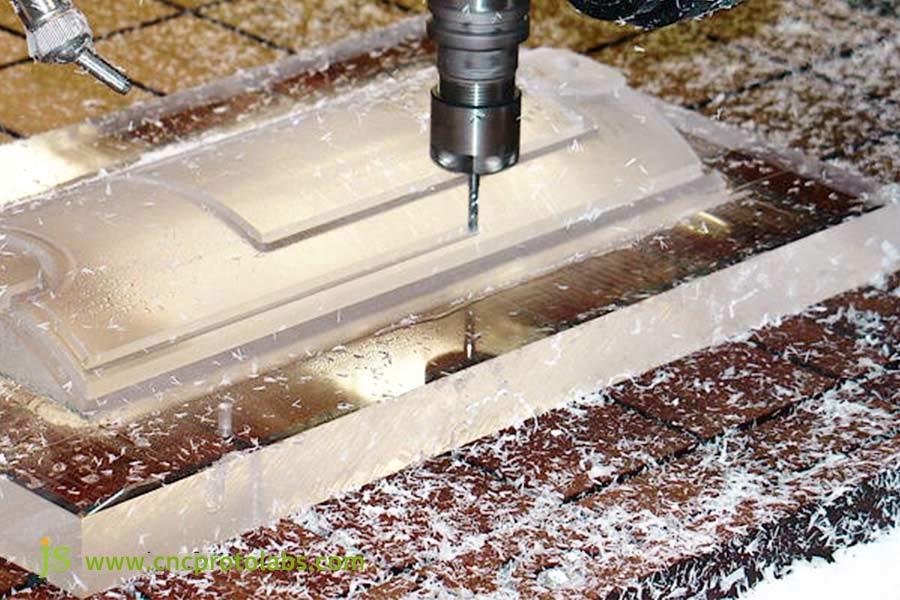Consider it: Your immaculately designed premium display case, to develop an acrylic panel crack at the edge while assembling, ruining its aesthetic appeal and undermining customer trust. Or even a critical viewing window on medical equipment, inadequately processed, with microscopic scratches or stress, resulting in distorted images.
These problems often occur due to the lack of familiarity with acrylic (PMMA) characteristics. While it's as clear as glass and durable as glass and an ideal material for general use, it's not as tough as metal and is extremely brittle! Traditional machining makes it prone to easily cracking and yielding very high scrap rates, a nightmare to work with.
CNC machining is the ultimate solution for regulating this transparent material. It determines and regulates the force and direction of each cut precisely, cutting effectively without wasting and damaging the material. In parts requiring strict dimension and surface finish, CNC-machined acrylic components not only achieve high accuracy and good-looking appearance, but also ensure more reliable performance.
So, how can you effectively utilize this CNC "tool" for fast and effective acrylic machining? Which parameters are crucial to success? What design pitfalls should you avoid?Let's get a bit further in order not to fall into these costly traps and master the processing of acrylic for real.
Core Answer Summary:
|
Core requirement types
|
Key strategies for CNC machining
|
Typical application examples
|
|
Ultra high transparency/optical grade
|
Specialized diamond cutting tools, high-pressure air cooling, extremely fine parameters. |
Lens, light guide plate, display window.
|
|
Complex and precise structural components
|
Sharp hard alloy cutting tools, layered cutting, shockproof clamping. | Instrument panels, model prototypes, and custom CNC machining parts. |
|
Low cost/rapid prototyping
|
Optimize tool path to reduce tool changes, standard parameters. |
Shell, label, decorative parts.
|
|
Batch production consistency
|
Highly automated, strict process control, online detection.
|
Consumer electronics components, lighting components.
|
This article will give your answers:
- This article will guide you through the four crucial points of acrylic CNC machining.
- We'll compare machining variance between different transparent materials and break down the most critical processes from design to finished product.
- Finally, using an example of a medical device window, we'll demonstrate how we use online CNC machining services to help customers achieve their specifications for perfect acrylic parts.
Why Trust This Guide? JS's Expertise In Machining Transparency Materials
Machining transparent materials of optical grade, particularly acrylic, is more than merely initiating a machine. The difficulties reside in regulating the machining temperature to avoid melting or whitening, varying the cutting speed, and creating clamping techniques that avoid deformation.
We appreciate that even small variations in water absorption and softening point between acrylic and materials such as PC and PS can directly affect final part quality and your cost of machining.
"As materials scientist Dr. Smith often emphasizes: A deep understanding of the polymer's molecular structure directly determines the upper limit of the machining process." This is precisely what we delve into daily.
This skill is a result of hands-on experience. From hairline tolerance light guides, to repeatedly sterilized to high temperatures transparent medical parts, to out-of-doors signage in high-traffic public places, we've produced and shipped tens of thousands of precision components.
We understand how to deliver perfect surfaces and dimensional accuracy simultaneously with efficiency balanced against cost containment. Such practical knowledge, accumulated over a lifetime of hard work on clear plastics, is our true value.
Four Core Elements For Successful Acrylic CNC Machining
I'm an engineer at JS Company. Before each acrylic CNC machining operation, we closely monitor four key points: Material selection, optimal tool selection, machining parameter adjustments, and precise finishing. These are key elements we've repeatedly verified in practice and are directly related to the final quality and efficiency of the job, so no compromise is allowed.
Element 1: Choosing the Right Tool and Processing Method
The key lies in three key points: a fast tool, good heat dissipation, and light cutting force!
- Optimal tool material: For a beautiful, smooth finish, diamond tools (PCD/Diamond) are preferred. For cost-effectiveness, ultra-fine-grain carbide tools are the preferred choice. Remember: avoid using worn tools; dull tools can cause problems!
- Tool geometry: We need tools with sharp edges (high rake angles) and polishing of the chip flutes on the blade. This reduces cutting effort and lowers heat and tool sticking significantly.
- Utilize cooling solutions: JS's preference is high-pressure air cooling, which relies on high airflow to carry away chips and cool the cutting point. Be extremely careful with cutting fluids! Regular cutting fluids have the potential to crack or fog acrylic easily. If you absolutely need to use one, use a non-solvent-based one specially formulated for PMMA (acrylic). It must be rinsed very well after machining, or the finish of the completed CNC machining parts will be affected.
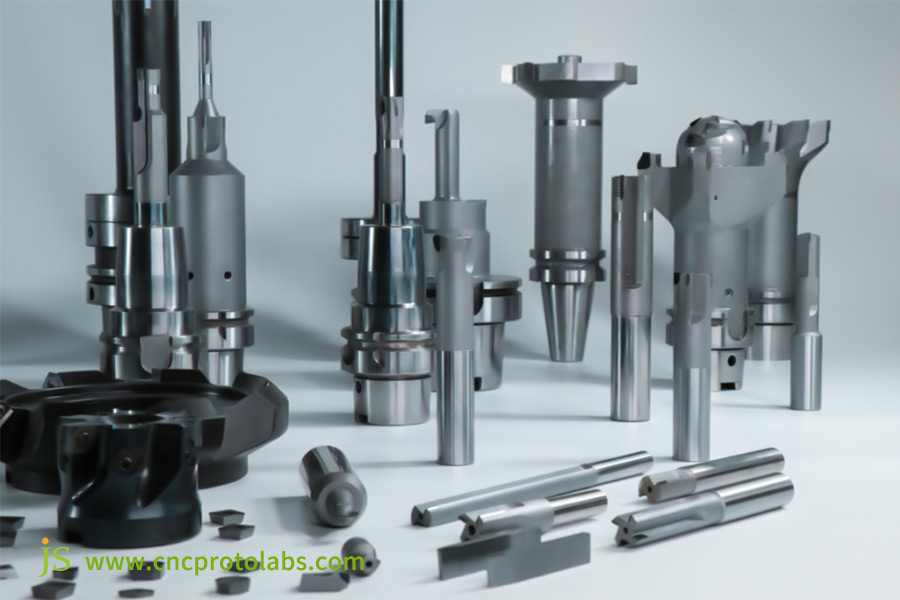
Element 2: Acrylic is not the sole transparent material
The following is a JS engineer summary comparison chart of CNC machining properties of transparent materials from field experience:
| Material |
Processing advantages
|
Processing shortcomings
|
Typical application scenarios
|
|
Acrylic (PMMA)
|
Light transmittance>92%, Ra<0.1μm after polishing, weather resistance for 10 years+. | Impact strength ≈ 2kJ/m², hot deformation temperature 80 ℃ (easy to melt). |
Instrument panels, advertising signs.
|
|
Polycarbonate (PC)
|
Impact strength 60kJ/m² (explosion-proof), temperature resistance 130 ℃. | Moisture absorption rate of 0.2% (required to dry at 80 ℃/4h), tool wear rate increased by 30%. |
Explosion proof shield, headlight cover.
|
|
Polystyrene (PS)
|
The cost is 30% lower, and the cutting speed can reach 2000mm/min. | The elongation at break is 1.5%, and the weather resistance level is UV3 (prone to yellowing). |
Display models and lighting accessories.
|
|
PETG
|
Impact strength 15kJ/m² (drop resistant), acid and alkali resistant PH2-12. | Surface hardness HB80 (easily scratched), hot deformation temperature 70 ℃. | Thin walled CNC machining parts for medical devices and food packaging. |
Data Source: Transmittance/roughness data are measured according to ASTM D1003/D523 standards.
Mechanical properties refer to ISO 527/180 test results.
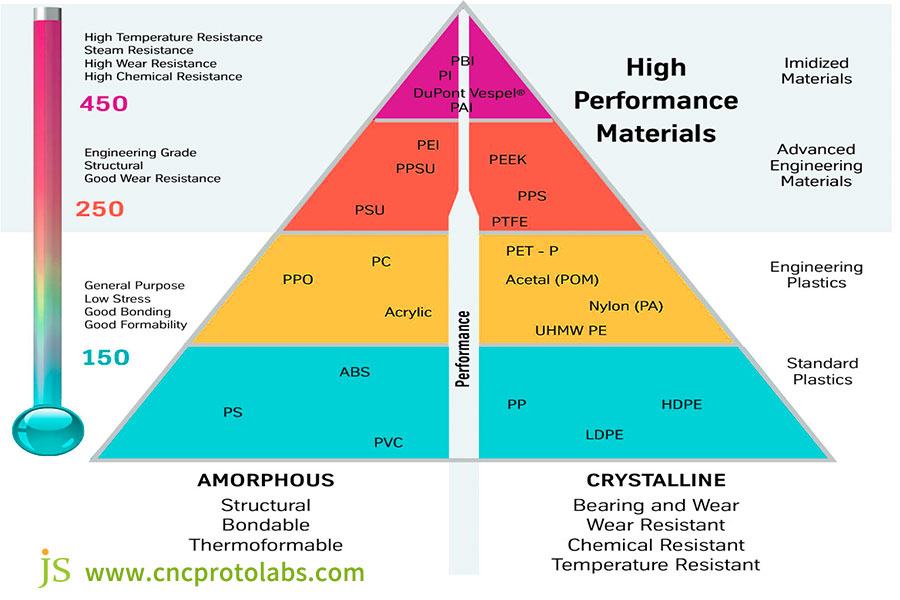
Iron Rules for Selecting Transparent Materials:
- For glass-like clarity and weathering performance, PMMA is optimal.
- For parts that need drop and impact resistance (e.g., explosion-proof covers), PC is the clear choice.
- For single parts or low-budget prototypes, PS or PETG can save 30% of the cost and are easier to process. Remember, however, no high-temperature applications for PETG!
"Based on JS's processing experience with over a thousand transparent components, material selection errors can cause the cost to rise by 50%! When you want to compromise on the light transmittance, toughness, and price, don't just consider acrylic—please approach us to help provide the best material solution!"
Element 3: Carefully Control Machining Parameters to Steer Clear of Heat and Force Pitfalls
In acrylic CNC machining, I'm very interested in strict control over parameters and processes. What I aim to avoid are the two pitfalls of heat and force. The following are key points and my shop-floor experience:
(1) Speed Control: I keep the spindle speed mid-to-high range, but never recklessly try to achieve high speeds, as it would burn the material. Proper feed rate depends on the tool used and the thickness of the material.
(2) Feed Rhythm: A steady, correct feed rate is crucial! Too slow and the tool will be rubbing constantly, building up friction and heat; too fast and the acrylic will crack or shatter. Finding that balance is key.
(3) Depth of Cut: My preference is a "small, frequent cut" strategy. Take smaller cuts each time and make additional passes. Especially in final finishing, leaving very little allowance is critical to obtain a fine surface and minimize stress.
(4) Toolpath: At programming, I attempt to make the toolpath as minimized as possible in order to prevent unnecessary runs and sharp corners. I use "climb milling" (where the cutter teeth mill from the outside of the material inwards) for a superior surface finish. Choosing a spiral or ramped entry for the cut reduce impact on the material very effectively.
(5) Ensure a secure and stress-free clamping:
A large, flat vacuum table is the best solution. This evenly distributes pressure and avoids localized stress concentrations that can cause cracking. Ensure the table surface is clean and airtight.
If using a mechanical clamp (press plate, vise), it is essential to:
- Use soft spacers (such as cork, dense rubber, or MDF scrap) between the clamp and the sheet.
- Apply force evenly to avoid excessive tightening that can cause sheet bending and internal stress.
- Avoid clamping areas where workpieces are being machined or thin-walled.
Element 4: Finishing Illuminates the "Transparent Soul"
I believe that the post-processing steps are the key to finally giving acrylic its "soul". In order to achieve the most optimal look for clear or colored work, these post-processing steps are unavoidable:
(1) Flame Polishing:
For getting a mirror-like, transparent edge, especially after the cut cast plate, flame polishing is the ideal method. Use a small, specialized spray gun like ours, moving swiftly and smoothly along the edge. The hot flame instantly melts the surface, which stays even and clear. Steady fingers and fast pace are the tricks. Practice a few times to develop the touch; too much burning will ruin the piece.
(2) Deburring/Chamfering:
Avoid forcing tiny burrs on corners! Sand them away gently with 600-grit or higher-grit sandpaper, or carefully scrape them off using a special plastic scraper. Always keep in mind, never use hard tools such as metal files, since they scratch easily.
(3) Grinding and Polishing:
Where flame is not feasible or the surface area is vast, patient polishing must be accomplished. Start with coarse sandpaper and increasingly move to finer sandpaper, increasingly scratching away. Finish with polish utilizing a plastic polish compound and a cloth wheel to restore the shine. This procedure takes somewhat time.
(4) Clean and Finish:
After all the above, clean out all the debris and process fluid in good time! Use a lint-free soft cloth and a mild detergent to wipe gently. Cleanliness is the foundation of a shiny finish.
"These four factors are all connected, and just fixing one or two is not sufficient. Our experience with our JS team is that only by fixing all three can we reliably and effectively create stunning, perfect acrylic parts."
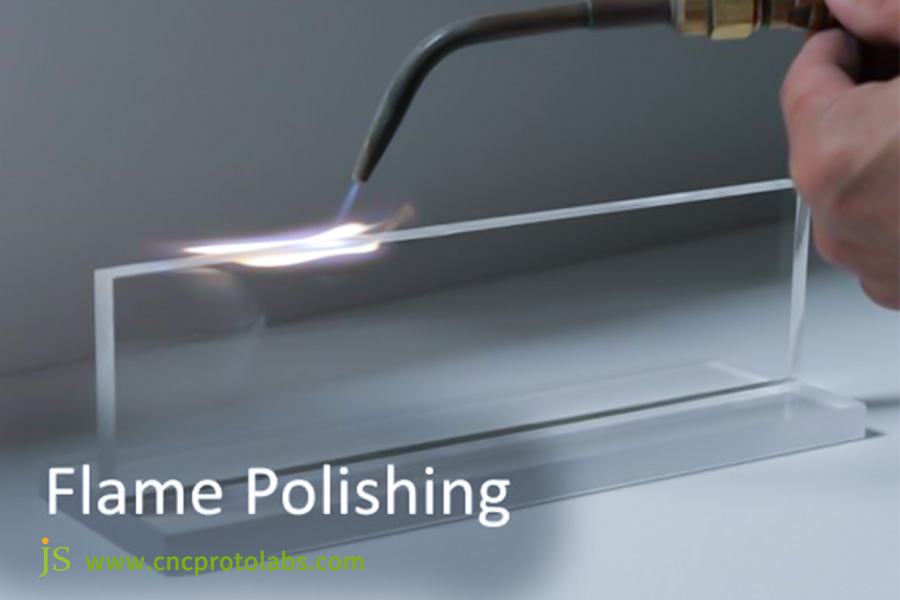
Practical Case Study: Acrylic Observation Window Production For Medical Dialysis Equipment
I was part of this project myself, and this project, in particular for observation windows on medical dialysis machines, left a great impression on me. The client was really on edge. The former supplier's acrylic windows were constantly experiencing issues with microcracks and edge fogging. This was not tolerable. We used robust technology to address this challenging issue:
Finding the root cause:
The client approached us with drawings, within a time limit, and needed an in-line CNC solution. Their previous observation windows had consistently been displaying tiny cracks along the edges and a misted surface. Worse still, they could not withstand repeated scrubbing with the harsh disinfectants used in hospitals. This clearly indicated a lack of correlation between the material, processing, and post-processing stages.
Our JS Customized Solution:
To address these pain points, we approached holistically, from material to post-processing, addressing the four key points as mentioned above:
- Materials: Normal acrylic would not do. We would not settle for anything but medical-grade PMMA sheet. The material is cleaner, with better internal stress control, and more optically transparent, stable, and far more resistant to disinfectants.
- Subtle but precise machining is the nuance of custom CNC machining manufacturing.
- Cutting tool is a new diamond-coated carbide milling cutter, which is hard and sharp.
- High-pressure air is utilized throughout the entire process to provide constant cooling so that overheating and material deformation are prevented.
- Tool speed and cutting volume are controlled to offer constant and constant cutting process.
- There is an extremely small tolerance left for finishing.
- Vacuum chuck fixture specifically made, in turn, holds the component in place, no clamping marks and unwanted stress.
- Optimization of the tool path, especially the feed, running in a spiral manner so as not to hit sensitive edges.
Post-processing is the finishing touch:
The machining is not complete yet! The edges are delicately chamfered and then buffed meticulously with a micro-flame to eliminate any potential micro-cracks or rough spots, leaving the surface mirror-smooth. The entire cleaning process is contactless, preventing secondary contamination or scratching. Finally, a special medical-grade protective film is applied to ensure flawless delivery to the customer.
Achievements and Value: From "High Scrap" to "High Reliability"
With this detailed plan, we successfully offered an observation window that completely addressed the customer's pain points:
- Optical Performance: Very high light transmittance, flawless edges, and no breakage. Long-term disinfection-induced enhanced surface fogging is <1% (standard materials typically have >15%).
- Dimensional Accuracy: Consistently controlled within a ±0.05mm tolerance, ensuring a perfect fit.
- Chemical Resistance: This is a breakthrough of major proportions! The edge cracking rate has fallen to 0% (compared to >60% for previous solutions). Our selected materials and processes ensure stable, long-term operation in various disinfectant milieus.
Key data on material chemical resistance (common disinfectants used in medical environments):
|
Material type
|
Resistance to isopropanol (70%) duration (hours)
|
Sodium hypochlorite resistance (500ppm) duration (hours)
|
Duration of resistance to peracetic acid (0.2%) (hours)
|
Main failure modes
|
|
Polycarbonate (PC)
|
500 - 1000
|
< 50
|
200 - 400
|
Stress cracking/severe yellowing.
|
|
Ordinary industrial PMMA
|
> 2000
|
50 - 200
|
100 - 300
|
Severe cracking/atomization/swelling.
|
|
Medical grade PMMA
|
> 2000
|
> 1000
|
> 500
|
Slight loss of gloss/slight swelling.
|
Source: ISO 10993-15, PlasticsEurope Medical (2023)
This transformation is significant:
We took a part that previously had a high scrap rate due to edge cracking and surface haze and turned it into a stable, reliable CNC machining parts. Not only does this improve the long-term reliability of our customer's equipment but also protects their brand reputation. Our transparent and honest CNC machining price model also gives confidence and trust to customers.
This case study clearly demonstrates that a thorough understanding of material properties, combined with precise machining techniques, can produce highly complex parts with reliability and precision.
"The dialysis equipment viewing window is just one example. If you're also looking for a reliable custom CNC machining manufacturing partner to solve your precise and demanding part challenges, the JS team is ready to assist you with our practical experience!"
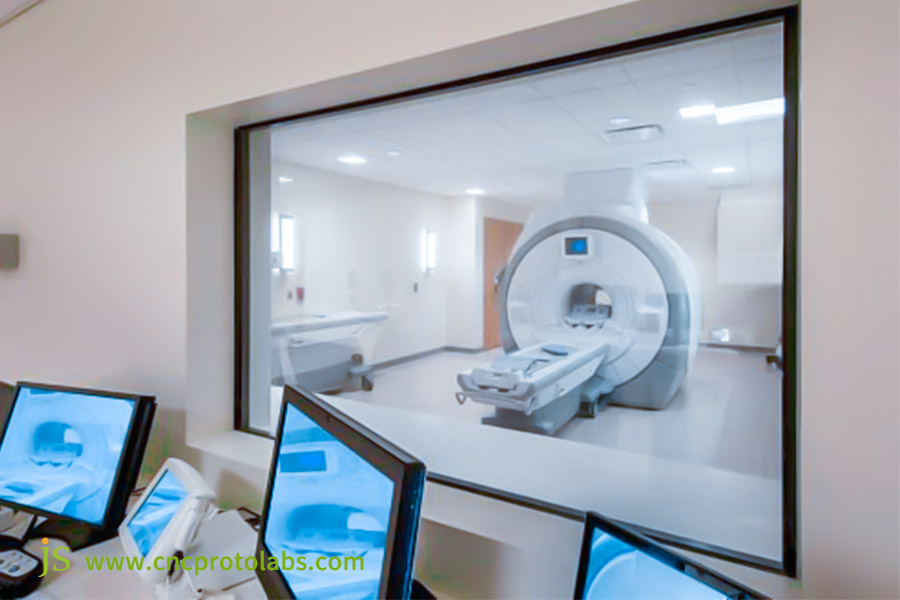
FAQs
Q1: What is the biggest issue machining acrylic? How can it be prevented?
The two biggest issues in machining acrylic are edge chipping and overheating.
- To prevent edge chipping: Cut with an ultra-sharp tool and with smooth, continuous cutting. Clamp lightly and evenly (JS prefers vacuum suction), and have a stable path design.
- To prevent overheating: cold, high-pressure air applied directly at the cutting edge is needed in order to cool. Feed rate and speed need to be precisely coordinated to enable heat dissipation. Reducing the number of stops also is crucial; the low friction that characterizes diamond tools can be a valuable advantage.
Q2: Why do my acrylic parts become whitish or hazy after machining?
Our store often has problems with whitish or cloudy edges on machined acrylic parts. This is most often because of overheating when machining.
The most common causes are generally dull tool frictional heat, too slow cutting speed that makes the tool appear as though it is grinding through the material, insufficient cooling air pressure or flow, or excessive spindle speed. Adjusting these parameters by themselves will normally fix the problem.
Q3: What are the primary drivers of the price of acrylic CNC machining?
JS Company has determined that the cost of acrylic CNC machining is driven by the following factors primarily:
Material, complexity of the part, surface finish, level of precision, and quantity order. Using a professional fabricator such as us will guarantee accurate and dependable quotes.
Summary
We all understand that acrylic CNC cutting is a lot more than plastic cutting. It requires comprehensive familiarity with the physical characteristics of the material, precise force, speed, and temperature control in machining, and specialized post-processing operations. Acrylic is brittle and heat-sensitive. Any slight laxity will lead to cracking or whitish or foggy edge, time and effort and time wastage. Creating highly transparent, detailed acrylic parts requires experience and expertise.
Take action now and let JS help you solve your problems:
- Professional Solutions: Stuck with extremely transparent, detailed acrylic pieces? Worried about poor quality or high cost? Don't be stuck in the middle between price and quality.
- Dedicated to Engineering Plastics: The JS group of experts is skilled in custom CNC machining of a broad range of engineering plastics, but especially acrylic. Complex designs are our specialty.
- Full-Scale Service: From material selection to best machining design (DFM), to precise machining and finishing such as flawless polish, we offer online CNC machining services in one.
Don't risk doing it yourself. Send your acrylic part CAD files to us today. You'll receive a transparent, realistic price quote and hands-on manufacturability guidance for your design immediately.
Disclaimer
The contents of this page are for informational purposes only.JS seriesThere are no representations or warranties, express or implied, as to the accuracy, completeness or validity of the information. It should not be inferred that a third-party supplier or manufacturer will provide performance parameters, geometric tolerances, specific design characteristics, material quality and type or workmanship through the Longsheng Network. It's the buyer's responsibilityRequire parts quotationIdentify specific requirements for these sections.Please contact us for more information.
JS Team
JS is an industry-leading companyFocus on custom manufacturing solutions. We have over 20 years of experience with over 5,000 customers, and we focus on high precisionCNC machining,Sheet metal manufacturing,3D printing,Injection molding,Metal stamping,and other one-stop manufacturing services.
Our factory is equipped with over 100 state-of-the-art 5-axis machining centers, ISO 9001:2015 certified. We provide fast, efficient and high-quality manufacturing solutions to customers in more than 150 countries around the world. Whether it is small volume production or large-scale customization, we can meet your needs with the fastest delivery within 24 hours. chooseJS TechnologyThis means selection efficiency, quality and professionalism.
To learn more, visit our website:www.cncprotolabs.com


